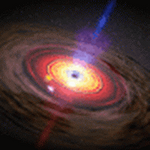
The ineffable Isaac Newton had a lot more going on than just formulating a few laws of motion. He was able to show that an apple falls to the earth for the same reason that the moon orbits the earth.
"Whoopee," you might think. But picture it . . . Newton had the sheer audacity to propose that heavenly objects and earthly objects follow the same rules.
In the late 1600's, this was unheard of. It was one thing for Galileo to have shown that the sun wasn't perfect, with its ever-changing spots. But to call into question the seemingly inherent separation of the mundane and the celestial? Breathtaking.
Newton expressed his laws of motion in mathematical terms. This made it possible to use measurements of what's happening now to predict what will happen in the future.
This predictability, this testability, this reliance on natural laws to explain the workings of the universe was at the heart of the scientific revolution. Three hundred years later, astronauts relied on Newton's physics to guide their journeys to the moon and back.
He also laid bare the essence of sunlight, as shown above.
Thanks to Newton, we've seen the Dark Side of the Moon.
Thursday, January 25, 2007
Scientist Friday
Posted by
Cheryl Shepherd-Adams
at
7:38 PM
![]()


No comments:
Post a Comment